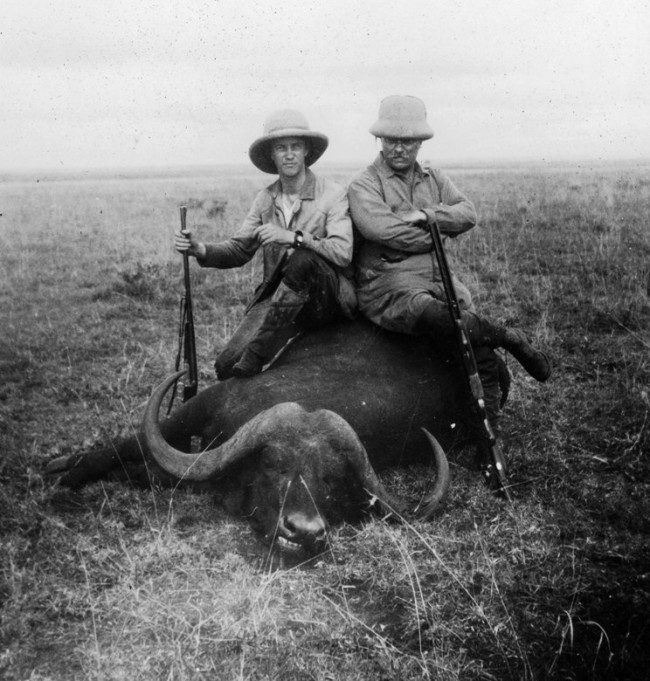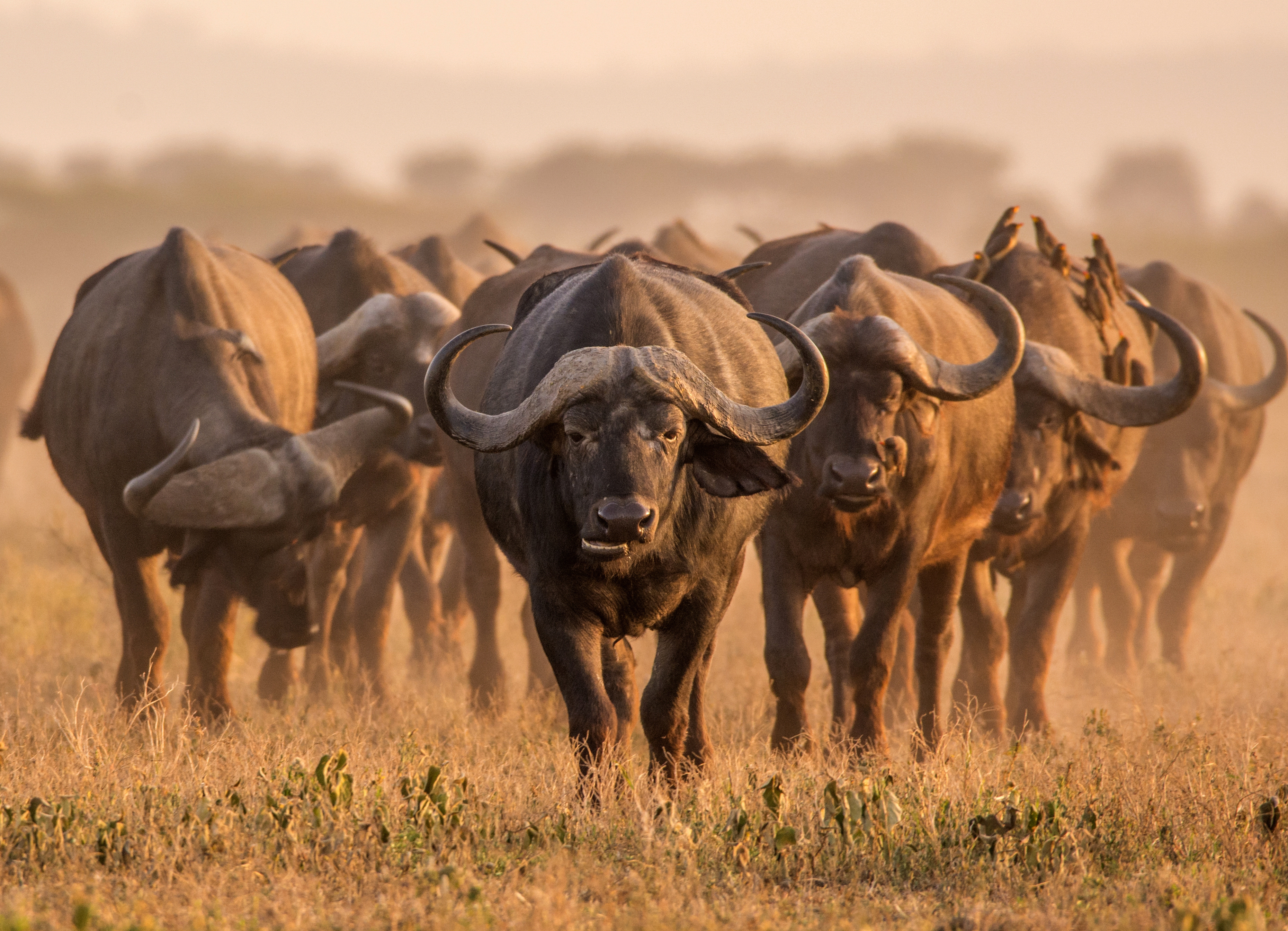Hunters from around the world met with outfitters last weekend at the annual Dallas Safari Club convention, planning their safaris and preparing to travel to Africa—and elsewhere—to hunt various species. While many opted to pursue the Dark Continent’s Big Five, trips for one member of the dangerous group were far more easily obtained than the others.
That animal would of course be the Cape buffalo, as elephants, lions, rhinos—and increasingly leopards—have been put out of many hunters’ reach by rising costs, falling populations, and increasing governmental restrictions. Today’s safari goer is more likely to purchase a buffalo hunt as a result.
Those interested in hunting Cape buffalo were in for a treat at this year’s DSC convention, as Craig Boddington, world-famous hunter and today’s leading authority on buffalo hunting, gave a free seminar on just this subject.
Boddington began with a brief history of the Cape buffalo, including a bit of detail about the famous photograph of Theodore Roosevelt and his son Kermit with their buff. A rinderpest epidemic had swept through much of Africa’s buffalo herds between 1895 and 1910, leaving Roosevelt with only a few good bulls—in truth, few buffs in general—to take. While the two hunters succeeded in getting museum specimens, Boddington said the bull they took would not be shot today due to its immaturity.

The Roosevelts with their impressive, albeit young, Cape buffalo. (Photo: theodore-roosevelt.com)
There are five species of buffalo for today’s African hunters to pursue: Southern Cape, Nile, Central African Savanna, West African Savanna, and Dwarf Forest. Buffalo tend to be smaller the farther north and west you go on the continent, with many hunters targeting the larger Southern Cape subspecies as a result. Boddington said there were six countries to seriously consider when planning a hunt for Southern Cape, each with their own subtle nuances.
Mozambique has one of the greatest concentrations of buffalo anywhere. The land is predominantly flat, swampy, and free of tall vegetation, meaning a hunt there will require lots of crawling and lots of glassing. Knee pads, gloves, and face cover are musts, as are long pants (to keep the leeches off when wading through water). Buffalo are relatively calm in Mozambique because there are no lions to stress them, so hunters often close to between 80 and 90 yards for a shot. Boddington showed images of one herd he encountered that stretched from one end of the horizon to the other, with as many as 3,000 buffalo in it.
Namibia has few buffalo overall due to the lack of suitable habitat, but the ones that are located within its borders offer stellar hunting opportunities. Many of these are in the Caprivi Strip, with “fantastic” trophy quality, Boddington said. Permits are fewer and more expensive in the country, but after glassing the landscape a hunter may get within 20 yards of a bull before shooting in the tall grass. Boddington called it a sleeper for good buffalo.
Boddington said he had never personally hunted South Africa, but the country offers fabulous genetics, disease-free herds, and comparatively low prices. Low-hanging horns adorn the bulls, but much of the hunting is done within fences.
Tanzania has great bulls in most of its hunting areas, but not all. Boddington killed his biggest buffalo there in the 1990s, and while a license allows for three buffalo per hunter, that may not be possible in real life. Solid planning on the hunter’s part can lead to a wonderful hunt.
Zimbabwe is one of Boddington’s favorite areas for buffalo hunting. The cover is fairly thick, requiring hunters to track versus glass. The buffalo are of average size, with many old, worn-down bulls. The thick brush hides the true number of good bulls present, but the animals you do see are impressive. The Zambezi Valley is a particularly suitable area.
Zambia is like Tanzania in that it doesn’t have that many ideal concessions, but Boddington said it was still a good bet with proper planning. Its hunting conditions are much like Zimbabwe’s.
The most common hunting technique for buffalo is the old-fashioned tracking job, with glassing a close second. Some PHs Boddington has hunted with have developed their own unique hunting styles, like using a red stag call to draw bulls in, or hiding in a black pup tent or behind an umbrella to approach a herd in the open.
Whatever technique is used, the goal is always to see and judge all the bulls in a herd. Using height, whether its a low rise or standing on someone’s shoulders, is useful when looking bulls over.
Boddington said shot placement was key, not firepower. Separate the bull into horizontal thirds and shooting just behind the shoulder at the top of the bottom third. A frontal or broadside shot works well, but never take a quartering-away shot.
Be careful that the black hide of the animal doesn’t confound your shot placement, and don’t be afraid if a front-shot buff appears to “charge you.” A bull shot this way often lurches forward out of instinct to the hit but usually turns after a few yards.
While he didn’t believe it in his youth, Boddington said he now considers the .375 H&H to be plenty of gun for buffs. Use a low-powered scope unless you absolutely insist on an open-sighted double rifle, but both can be fun and effective tools. Use solid 300-grain bullets when shooting lone bulls, but when a bull is surrounded by a herd, shoot soft loads to avoid a complete pass-through and injury to another animal.
Above all, listen to your PH. He knows the animals and area better than you, and in the event of a wounded animal, it will be his life that’s threatened by tracking it into the brush. “Black Death” is not a nickname given lightly.

